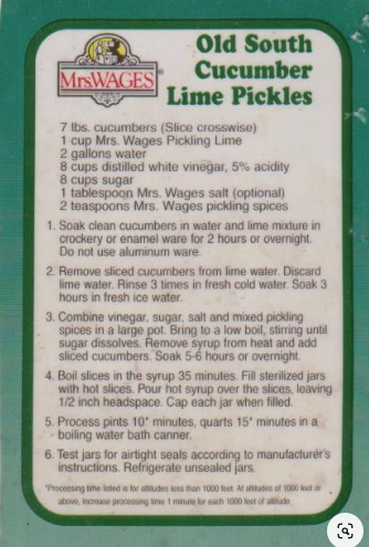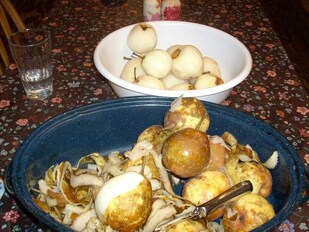🥫Canning & Preserving Foods🥫
 My figs photo My figs photo
Fig Preserves - I can mine the same as pear preserves. Equal amounts of figs and sugar. Cook until desired thickness, then can them. (Pictured above.)
Pick Your Own recipe and directions - Fig Preserves and Jam HOMEMADE SPICY LIME PICKLES
Recipe HERE My pickling photos.
Freezing Peas
Image by lisa runnels from Pixabay
Purple Hull peas are a necessity in a Southern garden, and if you don't or can't grow them you can almost always find them for sale at a local u-pick farm, roadside produce stand, or have neighbors who will sell them to you.
Once you get them, or pick them, it's important to spread them out on a sheet in a cool room if you are going to shell them yourself. This prevents them going through a heat and getting sour. Also important with other veggies, fruits etc. You can also soak them in cool water. It's very important to be ready for them when you get them. Things to have on hand: Big bowls for shelling A bucket or other container such as a clothes basket for the hulls/shells. (You can feed them to pigs, horses, chickens, goats.) A clean sink, to wash them, or use a big clean dishpan. A big colander to help rinse and clean them. A big pot to blanch*** them. Plastic containers, or freezer bags. Freezer space, of course. Basically, you shell them, wash them, put in boiling water and blanch them for 5 minutes, place in ice water until cool, bag them up and freeze them. ***Blanching (scalding vegetables in boiling water or steam for a short time) is a must for almost all vegetables to be frozen. It stops enzyme actions which can cause loss of flavor, color and texture.
National Center for Home Food Preservation https://nchfp.uga.edu › how › freeze › blanching OLD SOUTH CUCUMBER LIME PICKLES, or what I call my Sweet Lime Pickles.
My family's favorite home canned pickles. Stays crispy, not too sweet, not too salty, just right. I lost my old clipped recipe, and I'm so glad I had posted it on my Pinterest page! Here it is below! |
SO SIMPLE!!! Pear Preserves
After peeling, coring and slicing into slivers, add equal amounts of sugar and simmer until light pink, can in clean jars while still hot and seal (according to canning directions).
***In this particular batch, I added lemons to mine, but didn't particularly like it. They left a bitter aftertaste. ***I now add bottled lemon juice, or just the juice of fresh lemons, and a pinch of non-iodized sea salt to all of my fruit preserves to enhance the flavor. I can't deal with that bitter after-taste. Water bath canning:
Pressure Canning:
PRESERVING FRUITS-Historical
Make choice of the most perfect fruits for preserving. Let them be fair, unblemished, and free from specks of decay. These will discolor your syrup, give it a bad taste, and produce fermentation. Let your fruit be ripe, but not on the decline of its perfection; let it rather be approaching this desirable condition. There is no economy in using cheap or inferior sugar for preserving. The best clarified will do for cherries, plums, blackberries, and the like, intended for tarts or pies; but these should be well boiled, skimmed, and sunned. They should, too, be thoroughly done, till their syrup is very thick. Such may be kept in stone jars in almost any quantity, with pound for pound of sugar; but for all other preserves, glass tumblers or small glass jars are best. Sunning is very beneficial to preserves of all kinds. The best double refined loaf-sugar (or crushed) is indispensable for all fine preserves, and even these should be clarified with egg or isinglass. Preserves of every kind should be done slowly. Rapid boiling injures the form, and toughens and shrivels the skins of plums, cherries, and grapes, breaking such fruits as have been peeled, and often discoloring them and their syrup. Nor should your fruit be crowded in the preserving-kettle. This also spoils the form. Rather put in a few at a time, allow them to simmer slowly for ten or fifteen minutes, then taking them out carefully, one by one, with a silver spoon or perforated skimmer, lay them on dishes to cool while another portion of your fruit is preserving. Take these out in like manner in another dish, and so on till the whole quantity has been simmered; then begin at the first dish, and repeat the process till all your preserves become transparent: then remove them to the glass jars or tumblers designed for them. Boil your syrup till thick and clear, wait till it becomes nearly cool, and then pour it over the fruit. Close your jars well, either with good corks, papered at the bottom, or thick white paper. Set your preserves away in a cool, dry place. Examine them frequently, and if at all inclined to ferment boil them again, first adding a few spoonfuls of pounded white sugar to the syrup. Let them boil very gently. Set your jars in the sun for two or three weeks after your preserving is done, and there will be no danger of fermentation. Preserves should be carefully skimmed while doing. The skimmings need not be lost, as they will add very much to the strength of your vinegar. All the larger fruits should be pared. The paring should be narrow and thin. No preserve will keep well with less than pound for pound of fruit and sugar. Marmalades, jams, and jellies should be covered with a nicely-fitting paper in each jar, or tumbler saturated with brandy, and laid in so as to lie on the surface of the preserve. Besides this, the tumbler or jar should be covered with thick paper, and pasted down so as to exclude the air and insects. Mrs. Mary Mason, 1802-1881 |
|
DISCLAIMER: PLEASE READ AND FOLLOW DIRECTIONS AND CAUTIONS ON ACTUAL BAG!
***Canning is/can be a controverial subject for many. I'd rather say "follow the guidelines", than give anyone false, or potentially harmful information.
|
|







